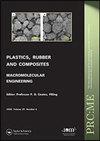A study on the effect of nano-ZnO on hygroscopic characteristics of PP/Wood flour composites
IF 1.2
4区 材料科学
Q3 MATERIALS SCIENCE, COMPOSITES
引用次数: 2
Abstract
ABSTRACT Polypropylene/wood flour composites having different nano-ZnO content were fabricated using melt compounding and subsequent injection moulding. The long-term water absorption and thickness swelling of the composites were studied for a range of water immersion times. It was found that the moisture absorption and dimensional stability of the specimens progressively decreased with an increasing nano-ZnO loading. The lowest water diffusion coefficient and swelling rate parameter were observed in the specimens produced with 4 phc nano-ZnO. The mechanism of water transport processes the specimens was proved to follow the kinetics of Fickian diffusion theory. Morphological findings revealed that the void content in the composite decreased by adding nano-ZnO. The hydrophobicity of the specimens reinforced with nano-ZnO improved by creating a tortuous path as a result of its characteristic barrier property. In comparison with the contact angle of untreated samples (71°), adding 4 phc of nano-ZnO increased the contact angle by 34% (95°).纳米zno对PP/木粉复合材料吸湿性能影响的研究
采用熔融复合和注射成型的方法制备了不同纳米氧化锌含量的聚丙烯/木粉复合材料。在一定的浸水时间范围内,研究了复合材料的长期吸水率和厚度膨胀率。结果表明,随着纳米zno负载的增加,试样的吸湿性和尺寸稳定性逐渐降低。4 phc纳米氧化锌试样的水扩散系数和溶胀率参数最低。水在试样中的输运过程遵循菲克扩散动力学理论。形貌结果表明,纳米氧化锌的加入降低了复合材料的空穴含量。由于纳米氧化锌特有的阻隔性,使其形成了弯曲的路径,从而提高了其疏水性。与未处理样品的接触角(71°)相比,加入4 phc的纳米zno使接触角增加了34%(95°)。
本文章由计算机程序翻译,如有差异,请以英文原文为准。
求助全文
约1分钟内获得全文
求助全文
来源期刊

Plastics, Rubber and Composites
工程技术-材料科学:复合
CiteScore
4.10
自引率
0.00%
发文量
24
审稿时长
4 months
期刊介绍:
Plastics, Rubber and Composites: Macromolecular Engineering provides an international forum for the publication of original, peer-reviewed research on the macromolecular engineering of polymeric and related materials and polymer matrix composites. Modern polymer processing is increasingly focused on macromolecular engineering: the manipulation of structure at the molecular scale to control properties and fitness for purpose of the final component. Intimately linked to this are the objectives of predicting properties in the context of an optimised design and of establishing robust processing routes and process control systems allowing the desired properties to be achieved reliably.
 求助内容:
求助内容: 应助结果提醒方式:
应助结果提醒方式:


